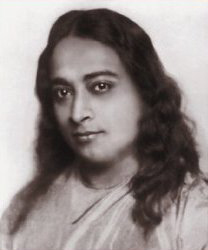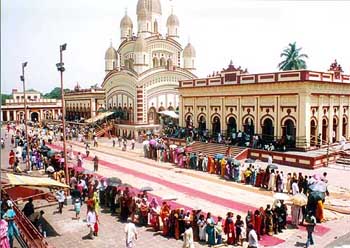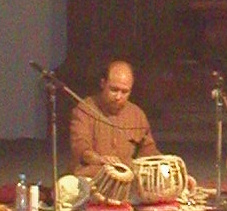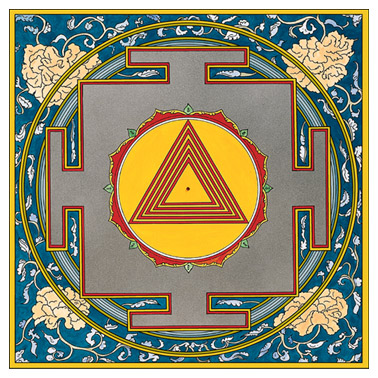
Hindu Personalities
There are thousands and
thousands of great personalities in Hinduism. This part
will be continually updated. Adi Shankara was a great teacher
too (8th century after Christ). Some contemporary teachers are also
mentioned here. I personally think that teachers included here were
correctly realized. Hinduism is incredibly diverse. Thus, it is better
to say that we generally do not deal with "false"
or "proper" Hinduism but with a greater
or lesser realization of it. Greater
realized Hinduism frowns
on conversion practices (like Christians uphold), as they often imply
need to manipulate other people. Therefore people of enlightening
ideas have always appeared throughout history not with
a goal to bring novel words but to shed light on the oldest
jewel whose appearance became deformed by our mind dust.
Those who search for Truth search for Sanatana
Dharma - it is the Heavenly Jewel
(Kaustubha) protected and hidden from public eyes. If you want to
see IT, pass like a wakening bugle
call among the pines and kiss the Sky.
This part (click here) contains some top
Indian musicians.
MORYA GOSAVI
Moraya Gosavi was one of the most devoted
followers of Lord Ganesh. He lived
in the 14th century and was a member of Ganapatyas, a secret
sect devoted to Ganesh. For Ganapatyas Lord Ganesh is Absolute God
and they believe that it is important to visit the eight shrines around
Poona, the main one being at
Cincvad (shrine) where Moraya Gosavi achieved moksha.
Jiddu Krishnamurti or J. Krishnamurti
Jiddu Krishnamurti or J. Krishnamurti (May
12, 1895 - February 17, 1986) was a well-known writer and speaker
on fundamental philosophical and spiritual issues. He publicly refused
attempts of other people to consider him a Buddha's incarnation; he
refused all organizations, manipulation, and encouraged people to
find the way to self-fulfillment from within themselves.
Paramahansa Yogananda
Paramahansa Yogananda
(1893 - 1952), born as Mukunda Lal Ghosh, was a great Indian guru
and teacher of yoga.  He brought some of the Eastern teachings to the West. In 1920, during
his visit in USA, he decided to stay in America where he founded the
Self-Realization Fellowship.
Its meditation centers are now around the world. Yogananda
led his pupils to direct contact (experience) with Absolute
Reality in opposition to blind faith in a guru. He used
to say, "The
true basis of religion is not belief, but intuitive
experience. Intuition is the soulís
power of knowing God". He was the master of Kriya
Yoga, the teaching of which he had received from a mysterious
teacher Mahavatar Babaji, whose
real name is not known. Mahavatar Babaji said that he was a
guru from the past and some important Hindu sages affirmed, too, that
Babaji was Krishna
Himself. Yogananda in his book Autobiography
of a Yogi wrote
that Babaji was already
beyond death. There
are more legends that say that in the remote parts of the Himalayas
there is a secret world of eternal masters - Shambala.
Paramhansa is often misspelled
as Paramahansa. No physical change
was observable on his dead body during 20 days after
his death, which was a miracle, as
physical bodies quickly
disintegrate after
death.
He brought some of the Eastern teachings to the West. In 1920, during
his visit in USA, he decided to stay in America where he founded the
Self-Realization Fellowship.
Its meditation centers are now around the world. Yogananda
led his pupils to direct contact (experience) with Absolute
Reality in opposition to blind faith in a guru. He used
to say, "The
true basis of religion is not belief, but intuitive
experience. Intuition is the soulís
power of knowing God". He was the master of Kriya
Yoga, the teaching of which he had received from a mysterious
teacher Mahavatar Babaji, whose
real name is not known. Mahavatar Babaji said that he was a
guru from the past and some important Hindu sages affirmed, too, that
Babaji was Krishna
Himself. Yogananda in his book Autobiography
of a Yogi wrote
that Babaji was already
beyond death. There
are more legends that say that in the remote parts of the Himalayas
there is a secret world of eternal masters - Shambala.
Paramhansa is often misspelled
as Paramahansa. No physical change
was observable on his dead body during 20 days after
his death, which was a miracle, as
physical bodies quickly
disintegrate after
death.
Lahiri Mahasaya
"My worship is of a very strange
kind. In this Ganga water is not
required. No special utensils are necessary. Even flowers are redundant.
In this puja all gods have disappeared.
And emptiness has emerged with euphoria."
Lahiri Mahasaya
Lahiri Mahasaya (1828 - 1895) was a great
guru who met the Eternal Master Babaji
in person and taught that if one lives honestly there is no need to
alter one's life in any noteworthy way in order to become aware of
God in us. He advised marriage
for most of his disciples along with Kriya Yoga practice. In
his teachings he generally avoided means of organized religion. Sri
Yukteswar Giri and Paramahansa Yogananda were his disciples,
but Yogananda brought Lahiri Mahasaya
to the West. Mahasaya is a Sanskrit
word meaning "great soul".
He was unusual among Indian holy men in that respect that he was a
householder - marrying, raising
a family, and working as an accountant for the British Government.
He achieved a substantial reputation among Hindu religionists.
Sri Ramana Maharshi
Sri Ramana Maharshi (1879 - 1950) was a great
Indian sage born in south India (Tamil Nadu). After his liberation
at the age of 16 he left his family and identified himself with Arunachala,
which is a Shiva's Holy Mountain
in South India. Sri Ramana was beyond all caste and religious
restrictions, and he did not belong to any lineage of teachers. His
teaching is based on self-enquiry
(Atma Vichara) and can be explained in
his words as simple as this: "Destroy
the power of
mind by seeking
it. When the mind is examined
its activities cease automatically. Look
for the source of mind. That source may be said to be God
or Self or Consciousness. Concentrating on one thought, all
other thoughts disappear; finally that
thought also disappears."
Karni Mata
Shri Karni Mata
is the incarnation of Devi Durga (Parvati).
All her life was full of miracles and her activities resulted in a
number of devotees who awaited her merciful blessings. It is believed
that she did not die but disappeared in the
divine light.
Shri Karni Mata
was born on October 2, 1387 AD in village Suwap in Jodhpur
District, Rajasthan. She belonged to the Charan caste.
She has a temple - Karni Mata temple,
a 600-year-old Hindu temple in
Deshnoke (Rajasthan, India).
In Deshnoke, she built a hut-shaped cave where she
meditated. In the year 1463 one of her stepsons drowned in a lake
and died. His dead body was brought to Deshnoke. His mother prayed
to Karni to give him his life back. Karni ordered to
keep the body inside the cave. On the fourth day the man came out
of the cave alive. Since then, the rats known as "Kabas"
have been reduplicating in the Deshnoke temple. There is a
legend that when she resurrected the man from the dead, she visited
the Yama's abode (Hindu god of death)
and had a quarrel with him, because he refused to accept her plea
that her followers should circumvent death. She finally found a way
how to overcome the Yama's imposition of death - every devotee will
bypass Yama and will become a member of the so-called
Depawat manifestation (Charan Caste) - that is,
a rat (Kaba). These rats - Kabas
- will be later reborn. In fact, they are not "rats". This
is the reason why these Kabas
in the Deshnoke temple are protected like her sons.
People from different cultures - Europeans or Americans
- may be surprised, astonished, or even scared when seeing thousands
of rats moving to and fro in the temple. In fact, these Kabas
are harmless and they do not let any unclean
rat come into the temple. For centuries, these Kabas
have lived here in isolation from the rest of the world and the world's
uncleanness. No disease has ever been reported from drinking the holy
Prasad, which is first offered to the holy
Kabas and then to devotees.
Khodiyar Maa is goddess from the Naga
kingdom - click here.
Aandaal
Aandaal is a
10th century saint (Tamil). She
belongs to Vaishnavism and is credited with
a number of admirable Tamil works (Thirupavai...). Strong devotion
to Lord Vishnu is what made Aandaal
known in Sanatana Dharma; she has some
temples, too.
Ramprasad Sen
Ramprasad Sen (1720-1781), almost always referred
to as Ramprasad, was a Bengali poet and singer of Hindu devotional
songs, especially the ones (Shyama Sangeet) devoted to Goddess
Kali. His songs are known as Ramprasadi.
His life was full of many mystical stories showing his devotion to
Kali. During adolescence, he exhibited
spiritual inclinations by writing devotional poetry. Ramprasad is
said to have the first vision of Mother Kali in a garden near
his house. His body allegedly glowed and people began to be attracted
to him.
Ramprasad was initiated into Tantric sadhana by a
great Tantric sadhaka Krishnananda Agamavagisa, the author
of Tantrasara. The Bengali Tantrasara is even today
the foremost source of much of the information on Tantric
Hinduism. Ramprasad practiced the brutal form of Tantric sadhana
- he visited places where most people are afraid to go (cremation
grounds).
Sri Ramakrishna Paramahamsa
Ramakrishna was a great Hindu religious teacher,
born in West Bengal. He disliked going to school and was not interested
in pursuit of money. He loved nature and spent his time in fields
and jungles with his friends. He soon started worshipping Mother
Goddess Kali. He was so impatient to see Her that
one day he decided to end his life. He seized a sword from the wall,
but before he could strike himself with it, he saw waves of light;
being overwhelmed by them he fell unconscious onto the floor.
Later, Ramakrishna was initiated into Advaita
Vedanta by a wandering monk named Totapuri; this occurred
in Dakshineswar (a city). Then he came to be known as Ramakrishna
Paramahamsa and is said to have begun to attract many seekers
of God. He was a very famous teacher.
Nisargadatta Maharaj
Sri Nisargadatta Maharaj (1897-1981) was a
great Indian sage, considered to be one
of the twentieth century's most articulate speakers of Advaita
Vedanta (a Hindu school of nondualism). A number of his
talks were compiled into a book entitled I
Am That, which achieved international acknowledgement.
Panini
An ancient Indian grammarian of Sanskrit.
Chaitanya Mahaprabhu
He was a monk and social reformer. He lived in the
16th century (Bengal and Orissa
in India). Sri Krishna Chaitanya
was a proponent of the Vaishnava school of Bhakti yoga (loving devotion
to Lord Krishna). He popularized the chanting of the Hare
Krishna mantra and started the school called Gaudiya
Vaishnavism (also known as Chaitanya
Vaishnavism). The ISKCON (Hare Krishna) movement is based on
this school.
Rani Rasmani
This wonderful woman was born in a poor low-caste
family, but one day, while touching the waters of Ganga, a
man in a boat got overwhelmed by her beauty. She soon became the wife
of this man; his name was Rajchandra Das. She became very rich and
the main deity she expressed her devotion to was Mother Goddess,
Kali. She was beautiful, liberal,
philanthropic, and she fought for human rights, too. There are many
stories describing her fearless attempts to support Indians against
British enslavement. One such a story, for example, describes how
she managed to struggle with the British when they imposed a tax on
fishermen whose livelihood strongly depended on fishing in Ganga River.
She bought part of the river for the then large sum of 10,000 rupees.
She erected a barricade by putting obstacles across the river and
when the British demanded that she remove the barricade, she retorted,
"If you return the money to me and abolish the fishing tax,
Iíll be happy to do as you want." The British Government
had to yield. "My Mother Kali will protect me, and if she
doesn't then nobody in the world can save me," she often
said.
 She
built the Kali Temple of Dakshineswar,
which you can see on the left (picture). The large temple complex
was built between 1847 and 1855. The Ramakrishna's brother was chosen
as the head priest of this temple, but he soon died. Then Ramakrishna
became the head priest. Dakshineswar is a town in India. You can also
find a different use of the Rani's name - Rani Rashmoni. This wonderful
woman started numerous charitable works and Sri Ramakrishna Paramahamsa
was appointed the head priest under her patronage.
She
built the Kali Temple of Dakshineswar,
which you can see on the left (picture). The large temple complex
was built between 1847 and 1855. The Ramakrishna's brother was chosen
as the head priest of this temple, but he soon died. Then Ramakrishna
became the head priest. Dakshineswar is a town in India. You can also
find a different use of the Rani's name - Rani Rashmoni. This wonderful
woman started numerous charitable works and Sri Ramakrishna Paramahamsa
was appointed the head priest under her patronage.
Personalities Of Indian
Classical Music
Music has always been a key that opens doorways
to chakras, perception, and God.
There are many types of music
in India, the modern styles too
(which duplicate the Western style of music like pop, jazz, etc.).
Classical Indian music can be
divided into Carnatic music -
associated with the southern part of the
Indian subcontinent, and Hindustani
music - typical for northern India, but also
Bangladesh, Pakistan, Nepal, and Afghanistan. Both genres
have their subgenres and they originated in the Vedic
period. Great historical composers
of Carnatic music are: Purandaradasa,
Thyagaraja, Muthuswamy
Dikshitar, Syama Sastri, Swati
Tinunal and more information about Carnatic
music can
be found here. The maestros of classical
Hindustani music are described on
this website.
Lord Krishna's favorite instrument was flute
and both genres (Carnatic and Hindustani) are also associated
with devotional inner
self. My purpose is not to list all important names
of Indian classical music, but
to give readers a quick guide where to start if willing to listen
to this enthralling music. Most of the musicians included herein can
be found on Youtube.com (video).
The Internet, too,
has a lot of information about these unique artists.
<>
Ananda VdoviŤ made one of the
best CD's I (and many other people say so) have
ever heard.
Anuradha Paudwal (also written
as Podwal) is a singer of Hindu devotional music - one
of the best I have ever heard. Video.
Ustad Alla Rakha and Ustad
Zakir Hussain are two of the greatest tabla players
in the world.
Anuradha Pal has been internationally
acclaimed as an accomplished soloist, a disciple of the above-mentioned
world-renowned tabla
maestros - Ustad Alla Rakha and Ustad Zakir Hussain.
She has performed in India, USA, UK, Europe, Australia, Japan... and
with top ranking musicians, too. In 1996, Anuradha formed a
female percussion group Stree Shakti. Video
on Youtube.com.
The Gundecha Brothers - Umakant
and Ramakant Gundecha, known as the Gundecha Brothers,
are leading Dagarvani dhrupad singers. Video
on Youtube.com
Hariprasad Chaurasia is an internationally
acclaimed flautist. He is universally regarded as the greatest
living master of the Bansuri - the North Indian bamboo flute.
In the Indian mythology, flute is associated with Lord
Krishna. Video
on Youtube.com.
Kala Ramnath was a prodigy child
and she, as a violin player, has successfully developed a style of
her own uniqueness. The violin that Kala Ramnath plays on is
of the same shape and design as the violin used in the Western world.
Video on Youtube.com.
Lakshminarayanan Shankar (born
on April 26, 1950), also known as L. Shankar,
Shankar or Shenkar, is a Tamil
violinist (not associated with Ravi Shankar), a
vocalist and composer. See
the video. He is considered to be one of the most prominent world's
virtuosos and his music has a breathtaking spirit. He produced
a very nice collection of CD's (Shakti) with John
McLaughlin, a famous (jazz) guitar player. L.
Shankar was a guest player of Phil Collins, Yoko
Ono and of many other celebrities. A
sample of his music in mp3.
Pankaj Udhas is a pre-eminent
Ghazal singer from India. He is
credited for bringing this unique singing style to the world. He was
born on May 17, 1951, in Jetpur in the Gujarat State of India.
He also cooperated with famous musicians such as Zakir Hussain
and Vikku Vinayakram. He comes from the Charan
community. Video.
Pandit Jasraj is a very famous
Indian vocalist (classical music).
He is a very important (if not the foremost) exponent of the Mewati
Gharana, which is a system of organization of Hindustani
classical music (Mewati is the name for this system). Jasraj
was born in 1930. This
video is dedicated to Lord Shiva.
Pandit Nikhil Banerjee was one
of the most prominent sitar masters of India. He was born in Calcutta
in 1931 and died in 1986. Video.
Begum Parweena Sultana - this
woman, also spelled as Parveen Sultana,
is a prodigious Hindustani vocalist.
She moved to Calcutta from Bombay at her young age. She is considered
Queen of Hindustani music.Video.
Balamurali Krishna, sometimes
also written as Dr. Balamuralikrishna,
is a very famous proponent of Classical Carnatic
music. He is a composer, a singer, a poet, an instrumentalist
and he was born in 1930. Video.
Abhijit Banerjee is
an excellent tabla player from India. His qualities put him on the
top scene of Indian classical music; he accompanied such  luminaries
as Pt. Ravi Shankar, late Pt. Nikhil Banerjee,
Begum Parweena Sultana, Pt. Jasraj, Pt. Shiv Kumar Sharma, Dr. Balamurali
Krishnan. Abhijit
has founded Dhwani Academy of Percussion
in Los Angeles, New York, Singapore, and Calcutta attracting
talented students from all over the world.
luminaries
as Pt. Ravi Shankar, late Pt. Nikhil Banerjee,
Begum Parweena Sultana, Pt. Jasraj, Pt. Shiv Kumar Sharma, Dr. Balamurali
Krishnan. Abhijit
has founded Dhwani Academy of Percussion
in Los Angeles, New York, Singapore, and Calcutta attracting
talented students from all over the world.
Subhankar Banerjee is one of
the most popular tabla artists on the Indian music scene. His
playing combines technical mastery with creativity. Video.
Ustad Mohammad Omar, the finest
rabab player from Afghanistan, became the first Afghan
musician to teach music in the United States (University of Washington).
Video.
Ustad Rais Khan is one of the
most gifted South Asian musicians. The magical sound of his sitar
has always magnetized audiences. Ustad Rais Khan descends directly
from the court musicians of the Muslim Mughal emperors of South
Asia, going back to the 15th century
AD. Video.
Ravi Shankar, born in 1920 in
Benares, India, is a Bengali Indian sitar player/composer.
Ravi Shankar is a leading Indian instrumentalist of the modern
era.
Sangeeta Shankar was born into
a famous family of traditional violinists. Sangeeta Shankar
began her musical training at the age of four. Initiated and trained
by her mother, she quickly mastered the intricacies of playing the
violin and started performing concerts when she was only thirteen.
Her career in music has been terrific. Video.
Shahid Parvez -
regarded as a prodigy child, gave his first professional
performance in Calcutta at the age of eight. Today he
is firmly established as one of the greatest sitar players
in the modern era of Indian Classical music. Video.
Shiv Kumar Sharma is one of the
truly great visionaries in the Hindustani classical music firmament.
He was born in 1938 in Jammu Kashmir. His father Uma Dutt
Sharma asked him to pursue the development of the Kashmiri
Santoor, an Indian stringed musical instrument believed to be
derived from the Persian santur. Video.
Shujaat Husain Khan (www.shujaatkhan.com)
is perhaps the greatest North Indian classical musician of
his generation. He belongs to the Imdad Khan gharana (tradition)
of the sitar. Shujaat has performed at numerous musical
festivals in India and has traveled around the world performing in
Europe, Asia, Africa, and North America.
Vishwa Mohan Bhatt, born in Jaipur
in Rajasthan in July 1952, is an exponent of Hindustani
music. Vishwa Mohan Bhatt (also known as V. M. Bhatt)
is one of the most celebrated shishyas (disciples) of the sitarist
Ravi Shankar. Video.
Vikku Vinayakram excels in the
field of Carnatic music. He is an exponent of the ghatam,
an Indian percussion instrument, actually a hardened earthen pot.
The ghatam is capable to produce high as well as bass tones.
Vinayakram is largely responsible for popularization of this
instrument. Video.
Rahul Sharma is the son of Santoor
virtuoso Shiv Kumar Sharma, who has transformed the rarely
played Indian Santoor into a favorite instrument attracting
world audiences.
Video of the Santoor duet - the father and son.
Back


